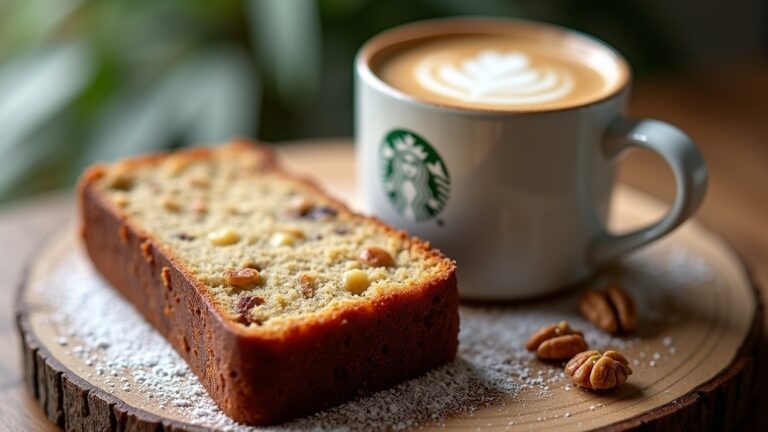Easy Focaccia Bread Recipe
I’ve perfected an easy focaccia bread recipe that captures the rich, olive oil-infused flavor and airy texture of this classic Italian treat. Just combine warm water and yeast, then mix with flour and salt. After kneading, let the dough rise until it doubles in size. Generously drizzle olive oil, creating dimples for that signature crispiness. The possibilities for toppings are endless, making each loaf a unique creation. Stick around to explore innovative flavor variations and tips for baking perfection!
Contents
History
When I plunge into the history of focaccia bread, it’s clear that this delightful flatbread has roots stretching back to ancient times. Its Italian origins are steeped in tradition, with evidence suggesting that early Romans baked a simple version using ancient grains like spelt and emmer. These grains were often combined with olive oil and herbs, creating a base that resonated with the flavors of the Mediterranean. Over centuries, focaccia evolved, adapting to regional tastes and ingredients, yet it retained that authentic rustic charm. As I explore its past, I can’t help but admire how this bread mirrors innovation—each generation adding its twist while honoring the original essence. It’s a reflection of culinary creativity that continues to inspire today.
Recipe
Focaccia bread is a delightful Italian flatbread that is both simple to make and incredibly versatile. Its rich, olive oil-infused flavor and airy texture make it a fantastic addition to any meal, whether served as an appetizer, paired with soups, or enjoyed on its own. This bread can also be topped with a variety of ingredients, such as herbs, olives, or sun-dried tomatoes, allowing for endless customization to suit your taste preferences.
Making focaccia is a rewarding experience that fills your kitchen with an irresistible aroma. With just a few basic ingredients and some patience, you can create a loaf that rivals those found in artisan bakeries. The key to a perfect focaccia lies in the dough’s hydration, the quality of the olive oil, and the resting times, which contribute to its unique texture and flavor. So roll up your sleeves and prepare to enjoy a homemade focaccia that will impress family and friends alike!
Ingredients:
- 4 cups all-purpose flour
- 2 teaspoons salt
- 2 teaspoons sugar
- 1 packet (2 1/4 teaspoons) active dry yeast
- 1 3/4 cups warm water (110°F)
- 1/4 cup extra-virgin olive oil (plus more for drizzling)
- Coarse sea salt (for topping)
- Fresh herbs (e.g., rosemary, thyme, optional toppings)
To prepare the focaccia, start by mixing the warm water, sugar, and yeast in a large bowl. Let it sit for about 5-10 minutes until frothy. In a separate bowl, combine the flour and salt. Gradually add the dry ingredients to the yeast mixture, stirring until a sticky dough forms. Add the olive oil and mix until well incorporated. Transfer the dough to a lightly oiled bowl, cover with plastic wrap, and let it rise in a warm place for about 1-2 hours, or until doubled in size. Once risen, gently stretch and flatten the dough onto a greased baking sheet, creating dimples with your fingers. Drizzle olive oil on top, sprinkle with coarse sea salt and herbs, if using. Let it rest for another 20-30 minutes before baking in a preheated oven at 425°F (220°C) for 20-25 minutes, or until golden brown.
For the best results, make sure you use high-quality olive oil, as it greatly enhances the flavor of the focaccia. Experiment with toppings, such as sliced olives, cherry tomatoes, or caramelized onions, to add a personal touch. Allow the focaccia to cool slightly before slicing, and consider serving it with a side of balsamic vinegar or olive oil for dipping. This bread is best enjoyed fresh but can be stored in an airtight container for a couple of days or frozen for longer storage.
Cooking Steps
Now that we’ve got our ingredients ready, let’s walk through the cooking steps to create that perfect focaccia. First, I mix warm water with yeast until it bubbles, then add flour and salt for a delightful dough. After kneading gently and letting it rise, I finish with a generous drizzle of olive oil for that signature flavor.
Step 1. Mix Warm Water and Yeast
To kick off the process of making delicious focaccia, I start by combining warm water and yeast in a bowl. The water temperature is essential here; I aim for about 100°F to 110°F—warm enough to encourage yeast activation but not too hot to kill it. I gently stir the mixture until the yeast dissolves, watching as tiny bubbles form on the surface, signaling that it’s coming to life. This step is critical for developing that airy texture we all crave in focaccia. I let it rest for about five to ten minutes, allowing the yeast to activate fully. The anticipation builds as I prepare for the next steps, knowing this simple blend is the foundation of my flavorful bread.
Step 2. Add Flour and Salt
With my yeast mixture bubbling happily, it’s time to introduce the dry ingredients. I grab my favorite flour types—like all-purpose and bread flour—for that perfect texture. Flour’s role is essential, providing structure and chewiness to the focaccia. Next, I add salt, which not only enhances flavor but also strengthens the dough’s gluten, giving it that irresistible rise.
Here’s what I do:
- Measure out the flour and pour it into a large bowl.
- Sprinkle in the salt evenly to guarantee every bite’s flavorful.
- Whisk together the flour and salt until combined.
- Create a well in the center for the yeast mixture.
This combination sets the stage for a delicious focaccia that’s ready to rise!
Step 3. Knead the Dough Gently
Gently folding the dough, I can feel its texture transforming under my hands. As I knead, I focus on the dough’s pliability, ensuring it becomes smooth and elastic. This kneading technique is essential for developing gluten, which gives focaccia its delightful chewiness. I use the palms of my hands, pressing down and pushing away, then folding back over itself. It’s fascinating how just a few minutes of this gentle kneading can elevate the dough texture from sticky to silky. I keep an eye out for the right consistency—firm yet tender. This hands-on approach not only enhances the flavor but also connects me to the process, making each loaf uniquely mine.
Step 4. Let Dough Rise for Hour
After kneading the dough, I carefully place it in a lightly oiled bowl, covering it with a damp cloth. This step is essential for yeast activation and achieving that perfect dough texture. I let it rise for an hour, and here’s what I notice during this magical transformation:
- The dough doubles in size, signaling successful fermentation.
- That enticing aroma starts to fill the kitchen, hinting at the flavors to come.
- I can see tiny bubbles forming, a sign that the yeast is hard at work.
- The surface of the dough becomes smoother and more elastic, ready for the next steps.
Waiting for this hour isn’t just time; it’s the moment that makes all the difference in my focaccia journey!
Step 5. Add Olive Oil Generously
As I prepare to shape my dough, I drizzle a generous amount of olive oil over it, ensuring that every inch is coated. The olive oil isn’t just a barrier; it’s a vital flavor enhancement that elevates the focaccia to new heights. I love how it seeps into the dough, creating a rich, aromatic experience that dances on my palate. Using my fingers, I gently spread the oil, allowing it to pool in the dimples I’ve created, which will hold onto more flavor during baking. This step is essential, as it contributes to that delightful crispiness on the outside while keeping the inside wonderfully soft. Trust me, don’t skimp on the olive oil—it’s the secret to focaccia perfection!
Nutritional Guide
When diving into the world of focaccia bread, it’s essential to contemplate its nutritional profile. This delicious treat boasts a variety of ingredient benefits, making it a delightful addition to your meals. Understanding its caloric content can help you savor each bite without guilt.
| Nutrient | Amount per serving |
|---|---|
| Calories | 200 |
| Protein | 4g |
| Healthy Fats | 6g |
The olive oil, our star ingredient, not only enriches flavor but also infuses healthy monounsaturated fats. The flour provides carbohydrates for energy, while herbs can contribute antioxidants. So, indulge in this innovative bread, and enjoy the goodness it brings to your table!
Final Thoughts
While I’ve shared various aspects of making focaccia bread, the experience of baking and enjoying it is truly what makes this culinary adventure worthwhile. Here are a few baking tips and flavor variations to elevate your focaccia game:
- Herb Infusions: Experiment with rosemary, thyme, or even sage for a fragrant twist.
- Cheesy Goodness: Add grated parmesan or mozzarella for a deliciously gooey texture.
- Savory Toppings: Try caramelized onions, sun-dried tomatoes, or olives for a burst of flavor.
- Sweet Surprise: Incorporate honey or figs for a unique, sweet focaccia experience.
Embrace your creativity; every loaf can be a new masterpiece. I can’t wait to see how your focaccia evolves—happy baking!
Frequently Asked Questions
Can I Use Whole Wheat Flour Instead of All-Purpose Flour?
I’ve tried using whole wheat flour, and it definitely adds nutritional benefits. However, the texture changes; it’s denser and heartier. If you’re up for a twist, go for it—it’s deliciously rewarding!
How Long Can I Store Leftover Focaccia Bread?
I usually store leftover focaccia bread in an airtight container at room temperature for up to three days. For longer freshness, I freeze it, which keeps its delightful texture and flavor intact for a month or more.
Can I Freeze Focaccia Bread for Later Use?
Freezing focaccia bread’s like preserving a summer sunset. I use smart freezing techniques, wrapping it tightly. Later, I thaw it slowly, letting its aroma bloom again. This way, each slice remains a warm, flavorful memory.
What Toppings Can I Use for Focaccia Bread?
When I top focaccia, I love experimenting with herb variations like rosemary or thyme. Adding cheese options such as mozzarella or feta elevates the flavors, creating a delightful and innovative twist every time I bake!
Is Focaccia Bread Suitable for a Vegan Diet?
Imagine pulling apart warm, fragrant focaccia. Yes, it’s perfect for a vegan diet! I’ve swapped dairy and eggs for innovative vegan substitutes, using olive oil and aquafaba as ingredient alternatives to create that delightful texture.
Conclusion
In the grand tapestry of baking, this easy focaccia bread recipe is a delightful thread woven with warmth and flavor. As you savor each fluffy bite, you’ll discover that even the simplest ingredients can create a masterpiece that dances on your palate. So, roll up your sleeves, embrace the magic of kneading, and let your kitchen become a haven of delicious aromas. Trust me, once you’ve tasted this bread, you’ll find yourself dreaming of your next baking adventure!








